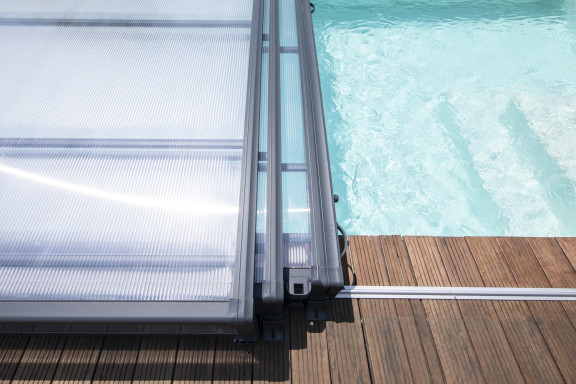What type of winterising for an above-ground pool?
With the arrival of cold weather, your above-ground pool should be prepared for winter. In most cases, you can perform active or passive winterising and complete this maintenance with a cover that is suitable for cold temperatures.
How do you winterise an above-ground pool?
There are three winterising solutions for above-ground pools:
- Pool draining, which is not really winterising and which will only apply to the smallest models (inflatable or self-standing pools).
- Active winterising, during which pool operation is reduced.
- Passive winterising, a total shutdown.
If your above-ground pool is installed permanently, you should choose active or passive winterising. The first will be adapted to mild climates while the second is preferable for places subject to frequent freezing temperatures.
Regardless of the type of pool you have in your garden, it must be winterised when the water temperature is stabilised around 12 °C. Indeed, winterising too early could facilitate the proliferation of micro-bacteria. However, winterising too late means taking the risk of seeing the water freeze over, which could damage your pool and equipment.
Can you drain an above-ground pool during the winter?
It is not usually recommended to entirely drain above-ground pools. Indeed, the water in the pool exerts pressure that enables the pool to maintain its shape. An empty pool could thus be damaged or crack.
The only exception to this rule is for small above-ground pools, which generally measure under 20 m3. Whether the pool is self-supporting, tubular or inflatable, the easiest way is to drain it entirely, clean it well and store it for the winter.
How do you actively winterise your pool?
Winterising an above-ground pool takes place in several stages:
1. Clean the pool entirely: walls, bottom, waterline, steps.
2. Perform a shock treatment if the water is dirty, and remember to run the filtration system for 24 hours.
3. Descale and clean the filtration system.
4. Pour a winterising product into the water.
During the winter, you should maintain your pool with:
- Daily filtration according to the water temperature (continuously below 0 °C, between 2 and 4 hours above);
- Regularly clean the filter;
- Monitor the quality of the water.
And for passive winterising? You will have no maintenance to carry out during the winter, but you should also remember to drain all equipment to prevent it from freezing and lower the water level below the filtration system.
How do you winterise an above-ground salt pool?
Winterising an above-ground salt pool is a little easier. Stop the electrolysis system below 15 °C, while maintaining filtration. Throughout the winter, you should monitor the limescale and corrosion of the installation, as well as the salt and pH level of the water, which should stay between 7.2 and 7.4.

How do you cover an above-ground pool?
To cover your above-ground pool in winter, use a strong winter tarpaulin that is suitable for cold temperatures. A waterproof tarpaulin will ensure the best protection; its hermetic properties help to create a barrier against both debris and sunlight in order to limit the appearance of algae.
You can also choose to use a net cover, which will require more frequent cleaning but is easier to handle. Lastly, a 4-seasons cover will be suitable for year-round use.
When and how do you install an above-ground pool tarpaulin?
The tarpaulin can be placed over your pool at the end of the winterising process. To be effective, it should be correctly attached in order to stay taut and in place.
1. Correctly position the tarpaulin.
2. Centre and place it evenly over the pool, making sure to leave the same edge overlap all around the pool.
3. Keep it in place using heavy objects at each angle.
4. Install the attachments.
How do you stretch an above-ground pool tarpaulin?
It is very important to correctly stretch the pool tarpaulin to prevent the accumulation of rainwater and sagging. The first thing to do is to obtain help: it is easier for two people to install a pool tarpaulin and stretch it correctly.
The attachments help to keep the tarpaulin taut. These attachments differ according to the type of tarp used, as well as the ground on which your pool is installed. Carefully read the instructions manual provided with the product in order to attach it correctly.
Unless you have a very small pool, there is no difference between winterising an above-ground pool and an in-ground model. This specific maintenance, designed to keep the pool in good condition during the entire winter, is essential. By giving it all your attention, you will keep your pool longer and above all enjoy it again when finer weather returns.


